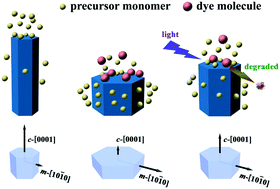Seeded growth of ZnO nanowires in dye-containing solution: the submerged plant analogy and its application in photodegradation of dye pollutants†
Abstract
Photocatalytic degradation of organic dye pollutants in wastewater is one of the most important applications of ZnO in environmental remediation. Insights into the facet-selective interaction of ZnO with dyes are instructive for structural engineering of ZnO nanowires with superior photocatalytic activity. In this report, we demonstrate the effect of different types of organic dyes as additives on seeded solution growth of ZnO nanowires. In the case study of the Eriochrome black T (EBT) dye, it is observed that EBT molecules with negatively-charged chromophores play a competent structure-directing role in restraining the oriented growth of ZnO nanowires along the c-axis. This effect, however, can be partially counteracted by introducing UV light irradiation into the growth solution due to the instant photocatalytic degradation of EBT adsorbed on the ZnO surface. The joint effects of EBT capping and light irradiation on the growth habit and morphology control of ZnO nanowires are suggested to be analogous to the situation of submerged plants, in which growth and morphological indices are affected by the quality of the water body and the light intensity in the aqueous environment. Exploiting the EBT dye as a structure-directing agent, we synthesize ZnO nanowire arrays with various fractions of the exposed (0001) surface on glass fiber cloth. When EBT is further selected as a model organic pollutant in solution, the ZnO nanowire arrays with the dominant exposed polar (0001) facet outperform others in photocatalytic degradation of EBT. This study provides an opportunity to “visualize” the facet-dependent interaction between organic dyes and ZnO, and offers a general approach to synthesising ZnO nanowire arrays with tunable morphological parameters and optimal photocatalytic activity.



 Please wait while we load your content...
Please wait while we load your content...